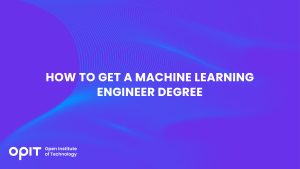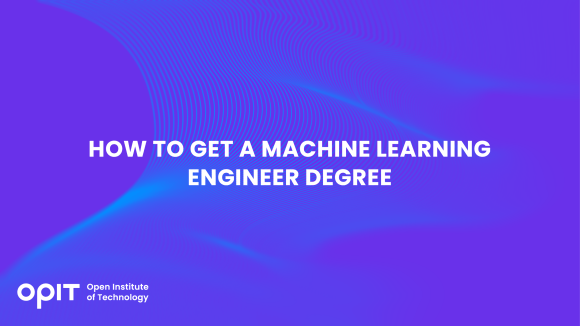

Why study for a machine learning engineer degree?
The simple answer is that the industry is growing explosively. Precedence Research points out that the machine learning market was worth $38.11 billion (approx. €35 billion) in 2022. By 2032, it’ll be worth $771.8 billion (approx. €712 billion). That means the machine learning industry will grow by an average of 35.09% per year between now and 2032.
That growth means one thing:
The industry is going to be looking for people with a machine learning engineer education.
If you pursue a machine learning engineer degree with an accredited institution – such as OPIT – you stand to be at the forefront of one of the fastest-growing industries in the world.
Machine Learning Engineer Education: The Foundation of Your Career
You’ll require a bachelor’s degree in a relevant field – such as computer science, at the very minimum, to start a career in machine learning. However, most roles ask for more. A master’s degree in a field like data science or software engineering will make you a more attractive candidate.
Those requirements also indicate the core subjects you’ll study when working toward a degree for machine learning engineer roles. Math, computer science, statistics, and computer science are all fundamentals that are vital to the industry.
As you move onto the master’s track, you’ll start learning more advanced machine-learning concepts, such as algorithms and data analysis.
Degree for Machine Learning Engineer: Choosing the Right Program
Signing up for the first machine learning engineer bachelor’s degree you find is rarely a wise course of action. You need to weigh your options carefully before choosing a course, with the following factors coming into play:
- Course Content and Curriculum – Look for degrees that include machine learning-specific components – such as feature engineering and model evaluation – ideally with a practical aspect that gives you real-world experience.
- Course Faculty – The “real-world experience” point also applies to your course’s faculty. The best programs are created by those who have experience in the machine learning industry. They understand what employers want to see, as well as the likely applications for the technical knowledge you’ll develop.
- Institution Accreditation – A lack of accreditation hurts the credibility of your machine learning engineer degree. Look for a program that’s accredited by a relevant authority, such as the European Qualifications Framework (EQF).
- The Cost – Master’s degrees in Europe can cost anywhere between €8,000 and €45,000, with the total you’ll pay being a determining factor for which degree you choose. Try to find a balance between the cost and the credibility of the organization offering the degree.
OPIT’s degree programs offer the ideal blend of these factors. They’re affordable – with tuition costing as little as €2,250 per term – and designed by faculty with real-world experience in the machine learning and computer science sector. They’re also accredited by the previously mentioned EQF.
Best Online and Offline Master Programs for Machine Learning Engineering
With the above factors considered, your next choice comes down to location:
Do you study offline or on?
The online course format delivers flexibility, though it means you don’t get to enjoy the on-campus lifestyle. Regardless of which you prefer, the following are the five top machine learning engineer degree courses available in Europe:
OPIT – MSc in Applied Data Science & AI
Beyond excelling in all of the above factors, OPIT’s MSc course offers a mix of live and pre-recorded content to make the online learning experience more interactive. There are no final exams – a relief for students who hate pressure-filled situations – with the course instead focusing on practical assignments with real-world applications.
University of Oxford – MSc in Advanced Computer Science
Offered by one of the U.K.’s leading universities, this MSc takes a broad approach to the AI sector, with machine learning as one of several components. It also covers cybersecurity and the emergence of AI in the medical field. A typical week involves 35 hours of study, eight of which are lectures, with another four covering practical sessions.
University of Cambridge – MPhil in Machine Learning and Machine Intelligence
An 11-month program, this master’s degree covers machine learning, as well as computer vision and robotics, speech and language processing, and how humans interact with computers. Practical exercises also give you a chance to work with Ph.D. students in the machine learning field.
KU Leuven – MSc of Artificial Intelligence
A multidisciplinary program, this master’s degree accepts students with backgrounds in subjects like psychology and economics. As such, it’s a good choice for those who have completed a bachelor’s degree in a non-tech subject and don’t want to restart their education careers. It covers the fundamentals but practically-minded students should beware – the course emphasizes technical knowledge.
Technical University of Munich – Data Engineering and Analytics MSc
Another on-campus degree, TUM’s course covers machine learning, along with key data science techniques such as computer vision and scientific visualization. But the focus is on Big Data – the driving force in everything from machine learning to self-driving vehicles.
The Future of Technology: Machine Learning Applications
You’ve seen the expected industry growth for the machine learning industry, but what about the applications of the knowledge you’ll gain from your machine learning engineer degree?
Simply put – the degree will apply to almost every industry, with a handful of examples including:
- Facial recognition technology development
- Financial fraud detection
- Enhanced analytics for the healthcare sector
- Predictive analytics
- Generative AI programs, such as ChatGPT
Online Education Advantages: Flexibility and Accessibility
Let’s assume you’d like to study to become a machine learning engineer but don’t want the on-campus experience for whatever reason. Are online degrees as valuable as their traditional counterparts?
They are, as long as the program is provided by an accredited institution like OPIT. Plus, studying online provides more flexibility in your learning schedule – giving you autonomy in how you complete your studies – and isn’t as individualistic an experience as it seems. For instance, OPIT schedules live video lectures, offers pre-recorded sessions, and creates opportunities for students to work together on real-world projects.
OPIT’s Master’s and Bachelor’s Programs That Help You Become a Machine Learning Engineer
There’s one more thing left to do:
Choose a machine learning engineer degree. OPIT offers three courses that set you on the path to a career in machine learning.
BSc in Modern Computer Science
Think of this course as a foundational machine learning engineer bachelor’s degree. You’ll combine learning about AI with the fundamentals of computer science – programming, data science, and database management, all included.
MSc in Responsible Artificial Intelligence
For those concerned about the ethical implications of AI, the MSc in Responsible Artificial Intelligence covers the machine learning bases. But it also shows you how to use what you’ve learned ethically to create sustainable AI systems.
MSc in Applied Data Science & AI
A more traditional degree for prospective machine learning engineers, this course builds on the previously mentioned BSc, with a specific focus on overcoming real-world problems using machine learning.
Choose OPIT
With the machine learning sector set for such pronounced growth, earning a specialized degree in the field now could set up your career for decades to come. Trust OPIT to provide that degree – it’s an EQF-approved online institution with exceptional degree programs.
Related posts

Source:
- Agenda Digitale, published on November 25th, 2025
In recent years, the word ” sustainability ” has become a firm fixture in the corporate lexicon. However, simply “doing no harm” is no longer enough: the climate crisis , social inequalities , and the erosion of natural resources require a change of pace. This is where the net-positive paradigm comes in , a model that isn’t content to simply reduce negative impacts, but aims to generate more social and environmental value than is consumed.
This isn’t about philanthropy, nor is it about reputational makeovers: net-positive is a strategic approach that intertwines economics, technology, and corporate culture. Within this framework, digitalization becomes an essential lever, capable of enabling regenerative models through circular platforms and exponential technologies.
Blockchain, AI, and IoT: The Technological Triad of Regeneration
Blockchain, Artificial Intelligence, and the Internet of Things represent the technological triad that makes this paradigm shift possible. Each addresses a critical point in regeneration.
Blockchain guarantees the traceability of material flows and product life cycles, allowing a regenerated dress or a bottle collected at sea to tell their story in a transparent and verifiable way.
Artificial Intelligence optimizes recovery and redistribution chains, predicting supply and demand, reducing waste and improving the efficiency of circular processes .
Finally, IoT enables real-time monitoring, from sensors installed at recycling plants to sharing mobility platforms, returning granular data for quick, informed decisions.
These integrated technologies allow us to move beyond linear vision and enable systems in which value is continuously regenerated.
New business models: from product-as-a-service to incentive tokens
Digital regeneration is n’t limited to the technological dimension; it’s redefining business models. More and more companies are adopting product-as-a-service approaches , transforming goods into services: from technical clothing rentals to pay-per-use for industrial machinery. This approach reduces resource consumption and encourages modular design, designed for reuse.
At the same time, circular marketplaces create ecosystems where materials, components, and products find new life. No longer waste, but input for other production processes. The logic of scarcity is overturned in an economy of regenerated abundance.
To complete the picture, incentive tokens — digital tools that reward virtuous behavior, from collecting plastic from the sea to reusing used clothing — activate global communities and catalyze private capital for regeneration.
Measuring Impact: Integrated Metrics for Net-Positiveness
One of the main obstacles to the widespread adoption of net-positive models is the difficulty of measuring their impact. Traditional profit-focused accounting systems are not enough. They need to be combined with integrated metrics that combine ESG and ROI, such as impact-weighted accounting or innovative indicators like lifetime carbon savings.
In this way, companies can validate the scalability of their models and attract investors who are increasingly attentive to financial returns that go hand in hand with social and environmental returns.
Case studies: RePlanet Energy, RIFO, and Ogyre
Concrete examples demonstrate how the combination of circular platforms and exponential technologies can generate real value. RePlanet Energy has defined its Massive Transformative Purpose as “Enabling Regeneration” and is now providing sustainable energy to Nigerian schools and hospitals, thanks in part to transparent blockchain-based supply chains and the active contribution of employees. RIFO, a Tuscan circular fashion brand, regenerates textile waste into new clothing, supporting local artisans and promoting workplace inclusion, with transparency in the production process as a distinctive feature and driver of loyalty. Ogyre incentivizes fishermen to collect plastic during their fishing trips; the recovered material is digitally tracked and transformed into new products, while the global community participates through tokens and environmental compensation programs.
These cases demonstrate how regeneration and profitability are not contradictory, but can actually feed off each other, strengthening the competitiveness of businesses.
From Net Zero to Net Positive: The Role of Massive Transformative Purpose
The crucial point lies in the distinction between sustainability and regeneration. The former aims for net zero, that is, reducing the impact until it is completely neutralized. The latter goes further, aiming for a net positive, capable of giving back more than it consumes.
This shift in perspective requires a strong Massive Transformative Purpose: an inspiring and shared goal that guides strategic choices, preventing technology from becoming a sterile end. Without this level of intentionality, even the most advanced tools risk turning into gadgets with no impact.
Regenerating business also means regenerating skills to train a new generation of professionals capable not only of using technologies but also of directing them towards regenerative business models. From this perspective, training becomes the first step in a transformation that is simultaneously cultural, economic, and social.
The Regenerative Future: Technology, Skills, and Shared Value
Digital regeneration is not an abstract concept, but a concrete practice already being tested by companies in Europe and around the world. It’s an opportunity for businesses to redefine their role, moving from mere economic operators to drivers of net-positive value for society and the environment.
The combination of blockchain, AI, and IoT with circular product-as-a-service models, marketplaces, and incentive tokens can enable scalable and sustainable regenerative ecosystems. The future of business isn’t just measured in terms of margins, but in the ability to leave the world better than we found it.

Source:
- Raconteur, published on November 06th, 2025
Many firms have conducted successful Artificial Intelligence (AI) pilot projects, but scaling them across departments and workflows remains a challenge. Inference costs, data silos, talent gaps and poor alignment with business strategy are just some of the issues that leave organisations trapped in pilot purgatory. This inability to scale successful experiments means AI’s potential for improving enterprise efficiency, decision-making and innovation isn’t fully realised. So what’s the solution?
Although it’s not a magic bullet, an AI operating model is really the foundation for scaling pilot projects up to enterprise-wide deployments. Essentially it’s a structured framework that defines how the organisation develops, deploys and governs AI. By bringing together infrastructure, data, people, and governance in a flexible and secure way, it ensures that AI delivers value at scale while remaining ethical and compliant.
“A successful AI proof-of-concept is like building a single race car that can go fast,” says Professor Yu Xiong, chair of business analytics at the UK-based Surrey Business School. “An efficient AI technology operations model, however, is the entire system – the processes, tools, and team structures – for continuously manufacturing, maintaining, and safely operating an entire fleet of cars.”
But while the importance of this framework is clear, how should enterprises establish and embed it?
“It begins with a clear strategy that defines objectives, desired outcomes, and measurable success criteria, such as model performance, bias detection, and regulatory compliance metrics,” says Professor Azadeh Haratiannezhadi, co-founder of generative AI company Taktify and professor of generative AI in cybersecurity at OPIT – the Open Institute of Technology.
Platforms, tools and MLOps pipelines that enable models to be deployed, monitored and scaled in a safe and efficient way are also essential in practical terms.
“Tools and infrastructure must also be selected with transparency, cost, and governance in mind,” says Efrain Ruh, continental chief technology officer for Europe at Digitate. “Crucially, organisations need to continuously monitor the evolving AI landscape and adapt their models to new capabilities and market offerings.”
An open approach
The most effective AI operating models are also founded on openness, interoperability and modularity. Open source platforms and tools provide greater control over data, deployment environments and costs, for example. These characteristics can help enterprises to avoid vendor lock-in, successfully align AI to business culture and values, and embed it safely into cross-department workflows.
“Modularity and platformisation…avoids building isolated ‘silos’ for each project,” explains professor Xiong. “Instead, it provides a shared, reusable ‘AI platform’ that integrates toolchains for data preparation, model training, deployment, monitoring, and retraining. This drastically improves efficiency and reduces the cost of redundant work.”
A strong data strategy is equally vital for ensuring high-quality performance and reducing bias. Ideally, the AI operating model should be cloud and LLM agnostic too.
“This allows organisations to coordinate and orchestrate AI agents from various sources, whether that’s internal or 3rd party,” says Babak Hodjat, global chief technology officer of AI at Cognizant. “The interoperability also means businesses can adopt an agile iterative process for AI projects that is guided by measuring efficiency, productivity, and quality gains, while guaranteeing trust and safety are built into all elements of design and implementation.”
A robust AI operating model should feature clear objectives for compliance, security and data privacy, as well as accountability structures. Richard Corbridge, chief information officer of Segro, advises organisations to: “Start small with well-scoped pilots that solve real pain points, then bake in repeatable patterns, data contracts, test harnesses, explainability checks and rollback plans, so learning can be scaled without multiplying risk. If you don’t codify how models are approved, deployed, monitored and retired, you won’t get past pilot purgatory.”
Of course, technology alone can’t drive successful AI adoption at scale: the right skills and culture are also essential for embedding AI across the enterprise.
“Multidisciplinary teams that combine technical expertise in AI, security, and governance with deep business knowledge create a foundation for sustainable adoption,” says Professor Haratiannezhadi. “Ongoing training ensures staff acquire advanced AI skills while understanding associated risks and responsibilities.”
Ultimately, an AI operating model is the playbook that enables an enterprise to use AI responsibly and effectively at scale. By drawing together governance, technological infrastructure, cultural change and open collaboration, it supports the shift from isolated experiments to the kind of sustainable AI capability that can drive competitive advantage.
In other words, it’s the foundation for turning ambition into reality, and finally escaping pilot purgatory for good.
Have questions?
Visit our FAQ page or get in touch with us!
Write us at +39 335 576 0263
Get in touch at hello@opit.com
Talk to one of our Study Advisors
We are international
We can speak in:


